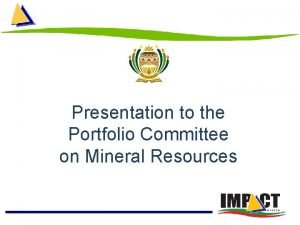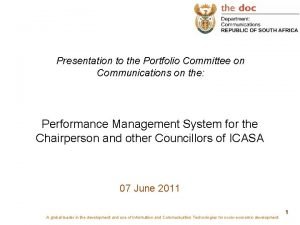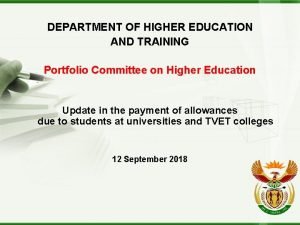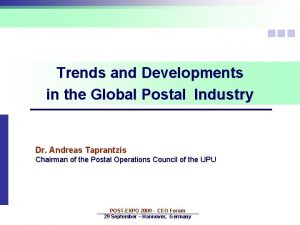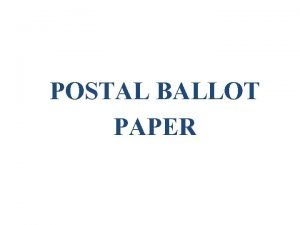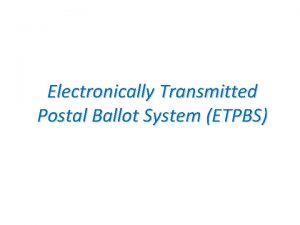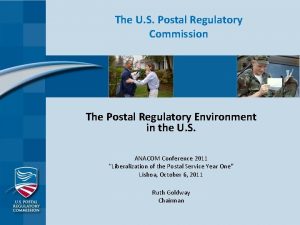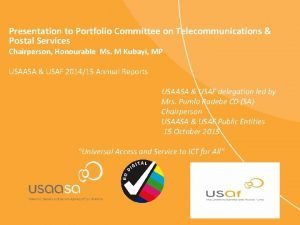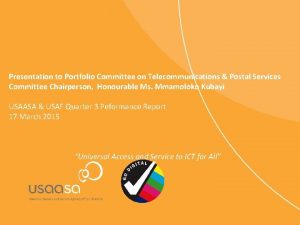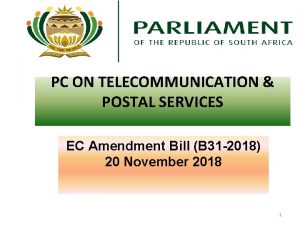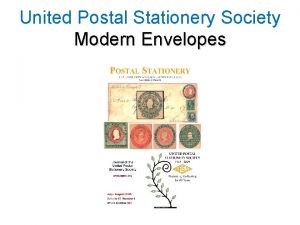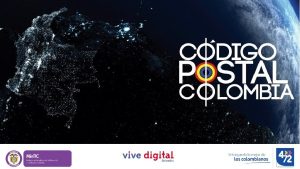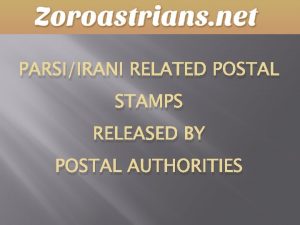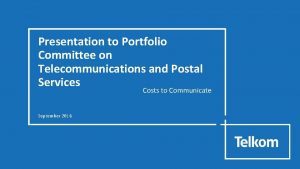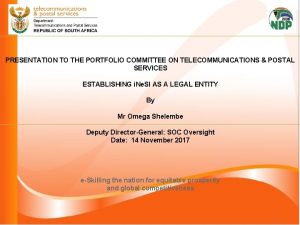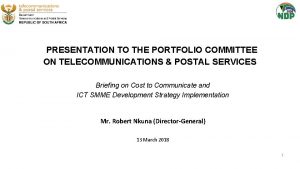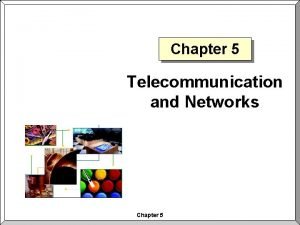Portfolio Committee on Telecommunication and Postal Services CSIRSIP




















- Slides: 20

Portfolio Committee on Telecommunication and Postal Services CSIRSIP Meraka Institute Presentation on Quality policy-relevant research Dr Ntsibane Ntlatlapa and Dr David Johnson Telecommunications and Media CSIR Meraka Institute 14 February 2017 1

Contents • CSIR Mandate • Trends in Communication Technologies • Context for our research programme • Our Telecommunications Research Programme • Recommendations - Policy Impact of our research programme 2

CSIR Mandate 3

Tension: How do we decide what research on? Rely on technology trends or government policies Research 4 Policy

2017 Trends in Communication Technologies IEEE Communication Soc • Future Communication Networks – 5 G begins to take shape – Spectrum allocation – new ways to manage spectrum – Internet of Things takes off • Smart and autonomous decision making – Artificial Intelligence, Deep Learning to boldly Go where no machine has played Go before – Driverless Everything – Internet of things • 5 • Put it all together and let it live in a Smart City A new generation of components and smart systems – Smart cyber-physical systems • Cybersecurity and cloud – Security, Privacy and Cloud – Distributed Ledgers, the end of banks and the beginning of a new way to run networks • EU H 2020 ICT programme Advanced Computing and Cloud Computing – Customized and low energy computing – Cloud computing • Future Internet – 5 G Research and Validation – Software technologies • Content – Big Data – Media and Content convergence • Robotics and Automation – Advanced robotics capabilities research and take-up

Strategic context – Policies that influence current CSIR research in Telecommunications 6

Key priorities Identified in the NDP Chap 5 • Adjust the market structures and remove legal constraints to enable full competition in services. • Implement a service and technology-neutral flexible licencing regime to allow flexible use of resources in dynamic and innovative sectors, especially for spectrum that should be made available urgently for next generation services. • Free spectrum for efficient use, to drive down costs and stimulate innovation. • Spectrum can be allocated with “set asides” or obligations to overcome historical legacies and inequalities in the sector, but this should not delay its competitive allocation. • Identify alternatives to infrastructure competition through structural separation of the national backbone from the services offered by the historical incumbent to create a common carrier with open access policies to ensure access by service competitors. 7

Required SET interventions to address the priorities Spectrum Sharing Network extension – 100% reach 8 Open access Data – Knowing what’s used where and when? Applies to both spectrum and network

Research on Spectrum Source: Spectrum Audit 790 -862 Mhz, study done by ICASA in 2010 Key questions: • Is spectrum scarce? • Studies show that in the US only about 10% of spectrum is in use at any one place at any time. • The usage maybe even lower in South Africa. • How do we authorize the use of this resource? 9

Spectrum Authorization Options Authorized primary use Individual authorizations (= Licensed) Authorized secondary use General authorizations (=license exempt = unlicensed) 10 Use under general authorization Exclusive access e. g. Cellular networks, broadcasting Shared Primary Access e. g. co-primary between Neotel and broadcasting 800 Mhz Shared spectrum Secondary Access e. g. ASA, Light-licensed TV white space Shared spectrum Secondary access e. g. unlicensed TV White Space Shared spectrum Commons access e. g. Wi. Fi, Bluetooth = facilitated or enhanced by cognitive radio and geo-location spectrum databases

Cognitive Radios • Cognitive Radios - the intelligent radio that can detect available channels (through geo-location database and/or spectrum sensing) in wireless spectrum, then accordingly changes its transmission or reception parameters • IEEE standards have released two standards for cognitive radio in TVWS bands – D-link released a product based on one of these standards in November 2016 11

Geo-location spectrum databases • • Enabling smart identification and sharing of unused frequency channels without causing interference. Enabling access to more spectrum for broadband m-2 -m – Creating Knowledge Based Industry in Rural Setting. – Impacting 5 G Standards to Contribute to Rural Broadband ! • CSIR GL-DSA Technology has receieved certification and licensed to Operate in the UK by OFCOM. – One of 7, including; Google, Microsoft and Sony 12

Advanced Networks and Services Models • Problem: – Future Communication networks need to support multiple services that currently require separate networks, e. g. in many areas, there are several M-2 -M networks (water, smart metering), broadcasting, broadband emergency networks. • Current Situation: – Terrestrial television network was built in isolation from telecommunication networks – Fibre network by incumbents is within 5 to 10 km of schools – Mobile networks by some incumbents reach above 80% of the country – New M-2 -M networks are being built to offset high-cost of using Incumbent networks 13

Technological advances: Network slicing use case MVNO 1, MVNO 2, CDN Mobile core 802 . 1 as Internet S-VL 802. 1 as AN C-VLA N 8 02. 1 as C -VLA Nn 1 N A L s C-V 1 a 802. 14 1 as AN S-VL N -VLA as C 1 802. 1 n SDN Switch Train station Managem ent • Software Defined Network Mobile Backhaul (c. SMB); • Isolate each slice of the network to avoid congestion on each slice based on Ethernet VLAN, MPLS labels, GRE

CSIR Research Enabling Infrastructure • • • 15 Received support from DST to build research enabling infrastructure Infrastructure – Cognitive Radio (strategies of delivering Broadband to rural areas) – Indoor testbed – Network Function Virtualization (v. EPC) – Outdoor testbed – Data centre Additional value beyond rural telecommunications: Smart City enabling Networks – SDN based Smart City enabling networks – SDN based strategies for monetization of smarty city networks

Data collection: Broadband Network and Spectrum Usage Monitor and Control Server • Programmable Network Interface Unit (PNIU – Low-cost Remote management and monitoring of edge of network – Monitor Service Level Agreement with ISP – Control network rules and flows for clients Site 1 Site N Programmable Network Interface Unit (PNIU) 1000 s of sites PNIU • 16 Spectrum monitoring at remote sites

Data analysis: Modelling of broadband infrastructure roll-out • A model containing the technology mix of broadband technology (fibre, copper, cellular, Wi. Fi, satellite etc. ). across the entire country • Contribute to broadband budget planning at national, provincial or local level • Contribute to the ICT RDI roadmap by quantifying the focus areas for research and development in future wireless technologies and broadband service infrastructure 17

Recommendations • Continue to support the process to allow new spectrum management regimes such as Dynamic Spectrum Access (e. g. TVWS, LSA) and adoption of Geo-location spectrum databases and cognitive radios. • Support the entrants of new operators into the market, including WISPs, community networks, and cooperatives – especially those that can serve underserviced areas - ensuring that they have access to appropriate spectrum at an affordable cost. 18

Recommendations • Continue theme of spectrum sharing into infrastructure sharing and support open access models for all infrastructure such utility poles, ducts and backhaul fibre as well as local loop fibre/copper. • Connection of open access telecommunications infrastructure to hubs such as public facilities (schools, libraries and clinics) in poorly serviced areas that new operators can use to lower the cost of their backhaul connectivity. • Mandate sharing of data on network infrastructure and spectrum usage 19

Thank You 20
 Portfolio committee on mineral resources and energy
Portfolio committee on mineral resources and energy Portfolio committee
Portfolio committee Portfolio committee on basic education
Portfolio committee on basic education Portfolio committee on communications
Portfolio committee on communications Portfolio committee on basic education
Portfolio committee on basic education Portfolio committee on higher education
Portfolio committee on higher education Personal values statement examples for students
Personal values statement examples for students Means of telecommunication
Means of telecommunication Chemdraw stationery document
Chemdraw stationery document Electronic contract law
Electronic contract law Postal rule
Postal rule Tarsila do amaral obra touro
Tarsila do amaral obra touro Postal industry trends
Postal industry trends Postal ballot paper format
Postal ballot paper format Postal audiovisual
Postal audiovisual Eco postal staff college
Eco postal staff college Handwritten alphabet recognition
Handwritten alphabet recognition Postal technology centre
Postal technology centre Electronically transmitted postal ballot system
Electronically transmitted postal ballot system Postal service form 3575
Postal service form 3575 Postal regulatory commision
Postal regulatory commision
